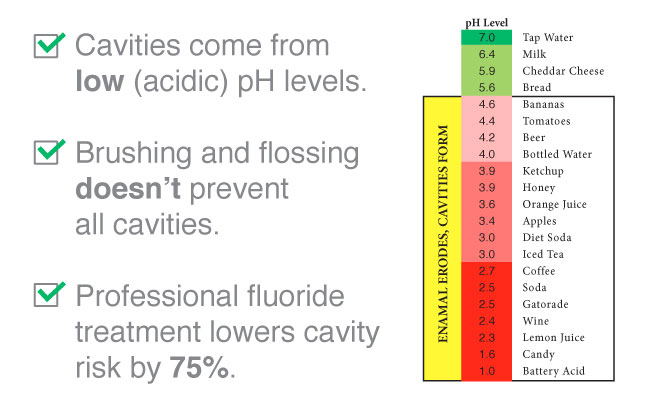The Caries Infection
Cavities are holes or soft spots that form in teeth as a result of the caries disease. Caries is an infection with the type of bacteria that can cause these holes in teeth. An infection is 1) an abnormal amount of bacteria, 2) bacteria that are living in an abnormal place, or 3) both. The caries disease is an abnormal amount of the type of mouth bacteria that like to make and live in acid. It is located in the thin biofilm on your teeth. Most types of bacteria living in the mouth are not acid loving and do not contribute to making cavities.
Contracting caries most often results from a variety of things happening simultaneously. First, you need to get the kind of germs that cause cavities (cariogenic) introduced into your mouth. They are often transmitted through common interactions like kissing and the sharing of foods and utensils. Then, conditions have to be right for those bacteria to settle and replace some of the non-cavity causing bacteria living in the biofilm on your teeth. Those conditions are made more favorable for the caries-type bacteria by having a diet that is high in the frequency of acidic foods. Also, a diet that frequently consists of sugar-containing foods allows the biofilm bacteria to make acid for about 30 minutes after each and every sugar exposure. These things create a favorable environment that allows the caries bacteria to multiply to a harmful level and become the infection.
Acquiring Cavities
Acquiring cavities, or holes in teeth, from this infection depends on several things. The first is saliva. Saliva protects teeth by washing away and diluting the acids, while simultaneously buffering teeth from the damage acids cause. People with dry-mouth problems caused by diseases or medications are especially prone to getting cavities, as they lack this protection. The next factor is the hardness of the tooth structure itself. Genetics play a role in this. Harder teeth are more resistant to acid attack. Tooth hardness can be changed with fluoride; it makes teeth harder, so acids can’t as easily dissolve them and make holes in them. Diet is a huge component! Sugar and acid attack the tooth structure every time they are in the mouth. The caries bacteria will make acid for about 30 minutes after each exposure to any sugar. Acid softens the teeth and eventually creates the hole or cavity. Lastly, having a lot of bacteria or a heavy amount of plaque on your teeth allows a greater number of bacteria to make more acid. When the layer of caries bacteria becomes very thick, more acid is produced. Getting cavities depends not only on having an abnormal amount of cariogenic bacteria but also on lower resistance to the bacteria’s harmful effects in the above categories. Some of these factors can be controlled by the patient, and some (like inherited tooth hardness) cannot.
Myths about cavities:
Myth #1
Brushing and flossing prevent cavities.
Brushing and flossing help minimize excess amounts of bacteria, but cavity-causing types of biofilm bacteria that live right against the tooth still remain after brushing and flossing in enough numbers to cause cavities.
Myth #2
Rinsing or brushing after eating sugar will prevent cavities.
The biofilm cavity-causing bacteria make acid for about 30 minutes after each sugar exposure. Rinsing and brushing don’t shorten this event.
Myth #3
Fluoride prevents cavities.
The tooth structure can be made more resistant to acid dissolution, but tooth enamel can’t be turned into to armor — the tooth can still dissolve with enough acid attacks.
Myth #4
Removing the decay from your teeth and placing dental restorations get rid of caries.
Removing the decay and placing dental restorations will fix the hole (the cavity), but it does not address the abnormally high level of acid-producing bacteria in the biofilm on all of the teeth. The caries infection in the biofilm remains. This is why patients often get cavities even after having dental work done.
Cavity-Prevention Tips
Though none of the tips below provide a cure for dental caries, when practiced together they make preventing the disease a real possibility.
- Minimize the frequency of sugar and acid-containing foods in your diet.
- Brush and floss to prevent excess bacteria from making extra acid on your teeth.
- Rinse with a base-containing mouthwash (Cari-Free® treatment rinse followed by maintenance rinse) to expose the acidic biofilm bacteria to an acid-neutralizing base. This creates an environment that acid-producing bacteria don’t like.
- Use prescription-strength fluoride toothpaste and rinses (such as Cari-Free toothpaste and maintenance rinse). This hardens the outer layer of the tooth and makes it harder to dissolve or decay.
- Use high-concentration xylitol products (Cari-Free gum and/or lollipops). Xylitol is a sugar alcohol that hinders the harmful bacteria’s ability to make acid from sugar.
- Get your cavities fixed so the holes don’t act as caries bacteria reservoirs.
- Encourage friends and family to do the same in an effort minimize cross-infecting one another.
- If you have a salivary flow problem, use xylitol moistening sprays (Cari-Free CTx2 spray). Avoid eating hard candies containing sugar, as the combination of sugar and dry mouth is destructive to healthy teeth. Ask us if you may be a candidate for pilocarpine medication to increase salivary flow.
- Get dental checkups on a regular basis. If you’re getting cavities, you don’t want the situation to worsen.
These things all work together, and the more of them you do, the fewer problems you’re likely to have. Our office stocks a number of Cari-Free products, like the CTx4 Toothpaste, CTx3 Rinse and the CTx4 Treatment Rinse. If we’re out of stock, or if you see something on their website (CariFree.com) that we don’t normally carry, let us know and we’ll get it ordered for you. Quite simply, they are the best we’ve found so far.
We are working on implementing a new diagnostic protocol in the office to try to help patients monitor their cavity risk and prevention progress.
 SCREENING INDICATIONS THAT YOU HAVE A BITE PROBLEM:
SCREENING INDICATIONS THAT YOU HAVE A BITE PROBLEM:
